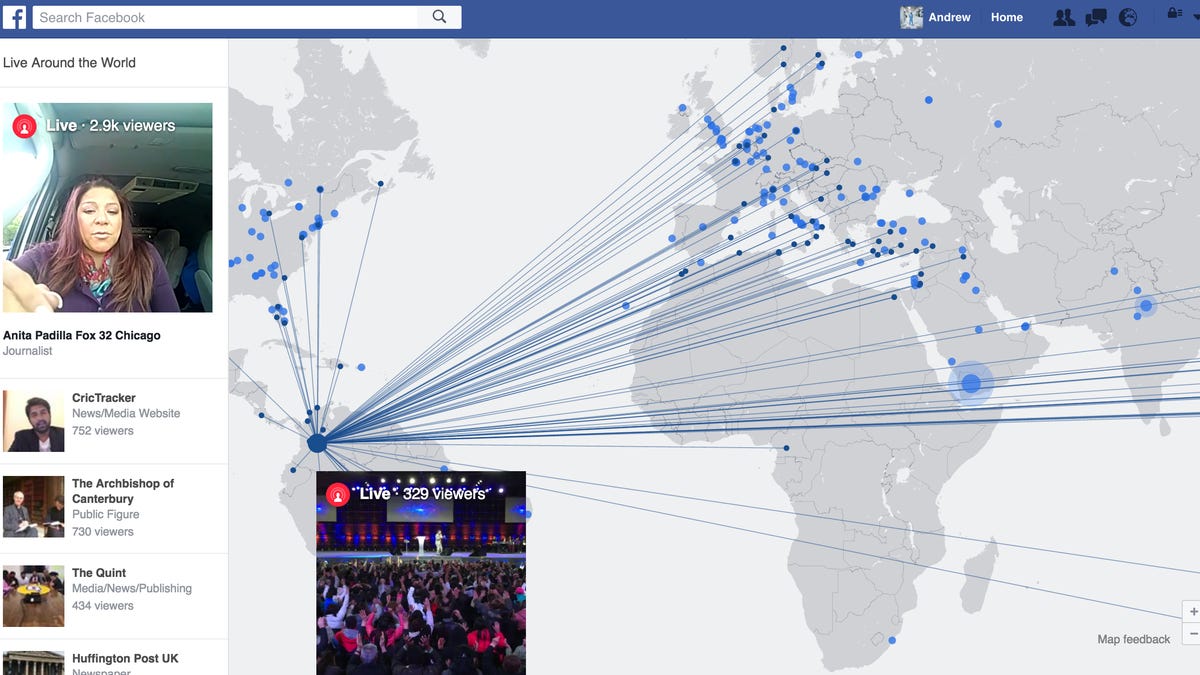Facebook quietly killed a map for discovering live videos
Some users want the map back.

Facebook's live video map
The map on Facebook displayed blue dots scattered across the world. When users clicked on them, live videos popped up.
Timothy Ballisty, a freelance meteorologist, used to scan the live video map during tornadoes, hurricanes and snowstorms, hoping to get a glimpse of what was happening in real time. Then, Ballisty noticed earlier this month that the map had vanished. Facebook had killed the feature late last year, but Ballisty and other users are just noticing.
The link for the map now directs visitors to Facebook Watch, the social network's video hub. Ballisty says that makes it harder for him to find the live videos he's looking for because he has to follow specific Facebook pages for storm chasers instead of just browsing a map.
"To take [the live map] away without any fanfare was kind of surprising to me," said Ballisty, who lives in North Carolina. "It was a very useful feature."
Ballisty isn't the only user to mourn the disappearance of the tool. Users took to the social network's help forum to ask what happened to the live map and implore the social network to bring it back. Some have speculated that Facebook got rid of the map because it didn't want users to see the atrocities being livestreamed on the social network, a constant problem.
The removal of the feature comes amid growing scrutiny over live video's place in society. What was once a tool for streaming silly stunts or personally important events has become a portal to murder, suicide and violence. In March, after the map was already gone, a terror suspect used Facebook Live to stream mass shootings at two New Zealand mosques that left 51 people dead. Facebook has grappled with the issue for years, and it remains a problem.
A Facebook spokeswoman said the company shut down the map because it wanted to consolidate its video pages, adding the live map had "low" usage. The spokeswoman declined to provide statistics on usage. Users can still find live video in Watch and on their news feeds, she said.
Other social media sites, including Twitter's Periscope and Snapchat, have maps for discovering live videos. But Facebook's size makes it harder to police the amount of offensive content that flows through its site. About 2.38 billion people log in to Facebook every month.
YouTube, the Google-owned video sharing service that has 2 billion logged-in viewers every month, has a channel to discover live videos but doesn't display them in a map.
"It makes sense that Facebook would pull back on things that expose it to higher risk," said Ted Schadler, a Forrester Research analyst. Location, he said, is a "tremendously powerful piece of data" and live video can be abused by criminals, terrorists and other bad actors like it was in New Zealand.
The Facebook spokeswoman said the map wasn't discontinued because of any safety or privacy concerns.
Facebook unveiled the live video map, which was only available on desktop, in a 2016 blog post. The map, the company said, "gives you a window into what's happening in the world right now."
In December, Facebook said it was trying to "unify the video experience" across the social network, but didn't mention it was phasing out the live video map.
A live video was shown on the map if users indicated a broadcast was public and shared their location. It debuted to mixed opinions, sometimes within the same review. TrustedReviews called the live map both "impressive" and "creepy." A Gizmodo reporter, who said she used the map to stalk strangers for six hours, called the live videos "novel, voyeuristic, fascinating garbage."
Brin McLaughlin from California said in an email that she enjoyed using the Facebook Live map because it was a "not-too-curated glimpse into people's broadcasts from all over the world."
She saw a baby being born in Quebec, coverage of an eclipse from Oregon and a street fair in the Canary Islands. Nowadays, on Facebook Watch, McLaughlin said she doesn't see the same variety of videos.
When the map disappeared months ago, the Facebook user noticed right away.
"I also absolutely understand the specific issues of liability where live feeds are concerned, and why Facebook has chosen to do it this way," she said. "I just wish they'd still give responsible users the option of using the map."

